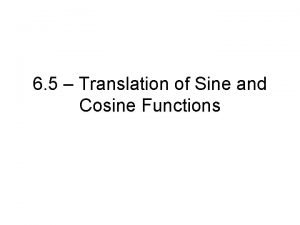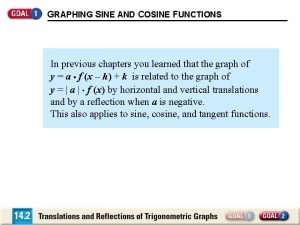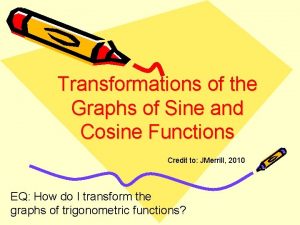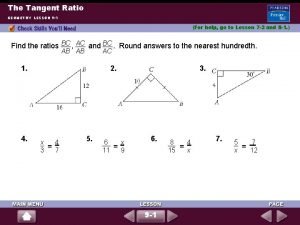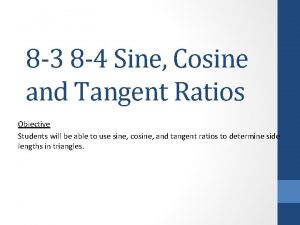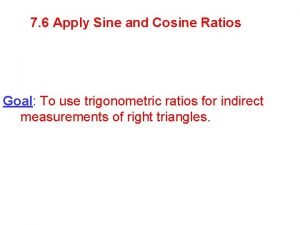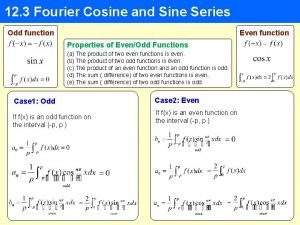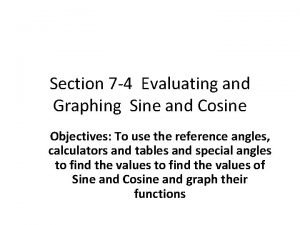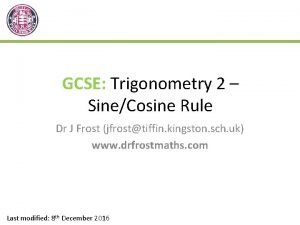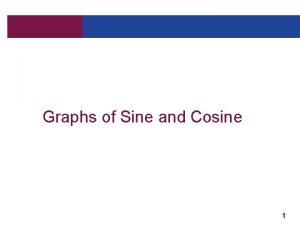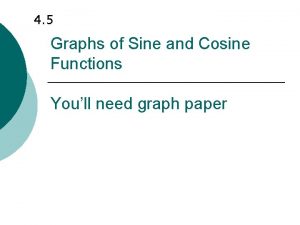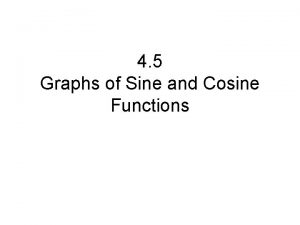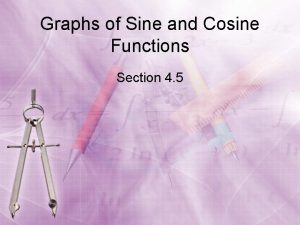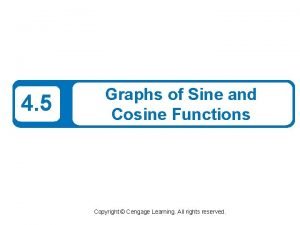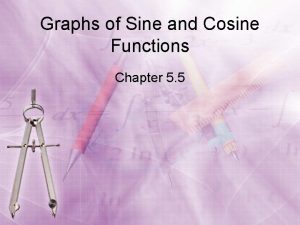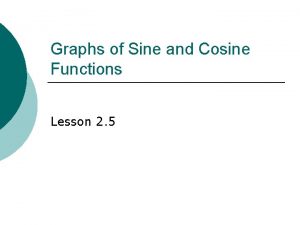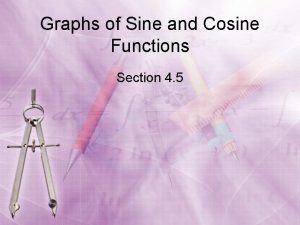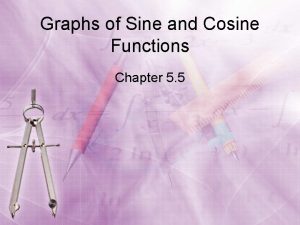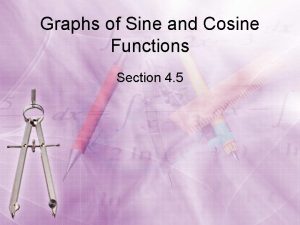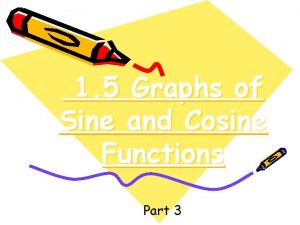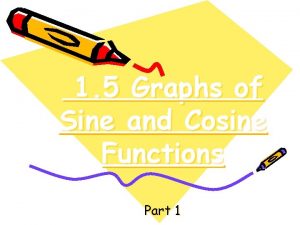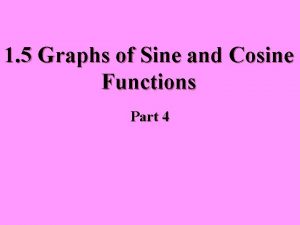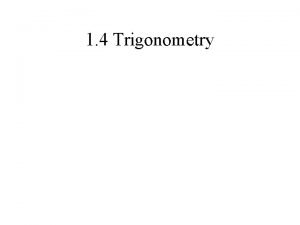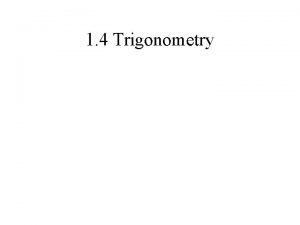Graphs of Sine and Cosine Functions Skill 25


























- Slides: 26

Graphs of Sine and Cosine Functions Skill 25

Objectives… • Sketch the graphs of basic sine and cosine functions • Use amplitude and period to help sketch the graphs of sine and cosine functions • Sketch translations of graphs of sine and cosine functions

Basic Sine Curve

Sine Curve

Basic Cosine Curve

Cosine Curve

Example –Library of Parent Functions: f (x) = sin x Sketch the graph of g(x) = 2 sin x on the interval [– , 4 ]. Solution: g(x) = 2 sin x = 2(sin x) means the y-values have twice the magnitude of the graph of f (x) = sin x. Divide the period 2 into four equal parts to get the key points

Example–Solution By connecting these key points with a smooth curve and extending the curve in both directions over the interval [– , 4 ]

Amplitude and Period of Sine and Cosine Curves y = d + a sin(bx – c) and y = d + a cos(bx – c). The constant factor a in y = a sin x acts as a scaling factor—a vertical stretch or vertical shrink of the basic sine curve. When | a | > 1, 1 the basic sine curve is stretched, when | a | < 1, 1 the basic sine curve is shrunk.

Amplitude of Sine and Cosine Curves The distance half way between the maximum and minimum values is called the amplitude

Example –Scaling: Vertical Shrinking and Stretching On the same set of coordinate axes, sketch the graph of each function by hand. a. b. y = 3 cos x Solution: Because the amplitude of is , the maximum value is and the minimum value is –.

Example 2 – Solution b. A similar analysis shows that the amplitude of y = 3 cos x is 3

Example–Solution y = cos x is a vertical shrink y = 3 cos x is a vertical stretch

Amplitude and Period of Sine and Cosine Curves The graph of y = –f (x) is a reflection in the x-axis of the graph of y = f (x). For instance, y = – 3 cos x is a reflection of the graph of y = 3 cos x

Amplitude and Period of Sine and Cosine Curves

0 < b < 1, 1 the period of y = a sin bx is greater than 2 and represents a horizontal stretching of the graph of y = a sin x. b > 1, 1 the period of y = a sin bx is less than 2 and represents a horizontal shrinking of the graph of y = a sin x. b is negative, negative the identities sin(–x) = –sin x and cos(–x) = cos x are used to rewrite the function.

Translations of Sine and Cosine Curves The constant c in the general equations y = a sin(bx – c) and y = a cos(bx – c) creates horizontal translations (shifts) of the basic sine and cosine curves. The graph of y = a sin(bx – c) completes one cycle from bx – c = 0 to bx – c = 2. By solving for x, you can find the interval for one cycle

Translations of Sine and Cosine Curves

Example–Horizontal Translation Analyze the graph of Solution: The amplitude is. Period is 2π, by solving the equations, and The interval corresponds to one cycle of the graph.

Example–Solution Dividing this interval into four equal parts produces the following key points.

Graph of the Tangent Function

Example–Library of Parent Functions: f (x) = tan x Sketch the graph of . Solution: By solving the equations x/2 = – /2 and x/2 = /2 Consecutive asymptotes are at x = – and x = .

Example–Solution

25: Graphs of Trig Functions � Summarize � Videos � Homework ◦ Worksheet � Quiz Notes

Graph of the Tangent Function That is, tan(–x) = –tan x. y = tan x is symmetric with respect to the origin. From the identity tan x = sin x/cos x that the Tangent function is undefined when cos x = 0. Two such values are x = /2 1. 5708.

Graph of the Tangent Function
 Sine and cosine graphs
Sine and cosine graphs How to find period from sine graph
How to find period from sine graph Graphing sine and cosine quiz
Graphing sine and cosine quiz 4-4 graphing sine and cosine functions worksheet answers
4-4 graphing sine and cosine functions worksheet answers Sine function graph
Sine function graph Horizontal phase shift
Horizontal phase shift Transformations of sine and cosine functions
Transformations of sine and cosine functions Graph of sine and cosine functions
Graph of sine and cosine functions Phase shift sin
Phase shift sin Graph of sine and cosine functions
Graph of sine and cosine functions Transformations of sine and cosine functions
Transformations of sine and cosine functions Lesson 13-2 sine and cosine ratios answer key
Lesson 13-2 sine and cosine ratios answer key When do you use the sine and cosine rule
When do you use the sine and cosine rule Sine and cosine law maze
Sine and cosine law maze Soh cah toa rule
Soh cah toa rule Sine and cosine rule
Sine and cosine rule Inverse sine function
Inverse sine function Sine rule and cosine rule
Sine rule and cosine rule Cosine word problems
Cosine word problems Cosine tangent sine
Cosine tangent sine Sine and cosine ratios
Sine and cosine ratios Fourier series half range
Fourier series half range Sine function transformations
Sine function transformations The sine graph
The sine graph Trigonometry dr frost
Trigonometry dr frost The sine and cosine curves intersect infinitely
The sine and cosine curves intersect infinitely Sine and cosine law
Sine and cosine law





